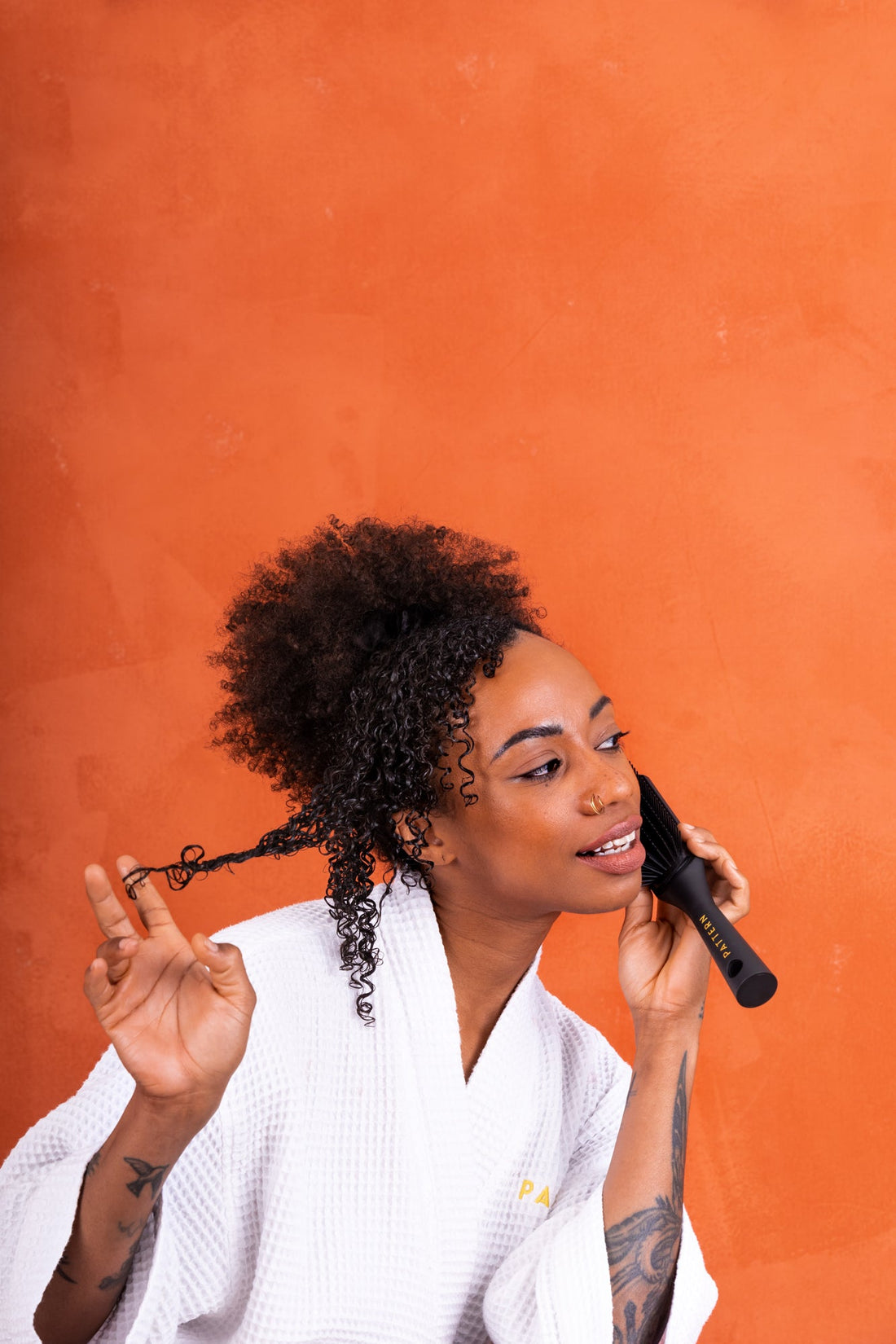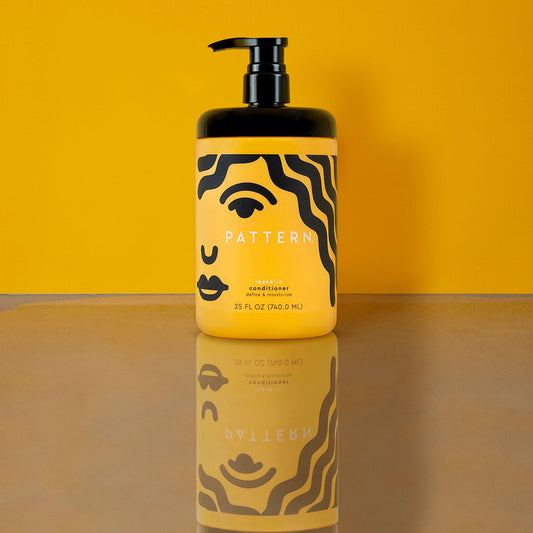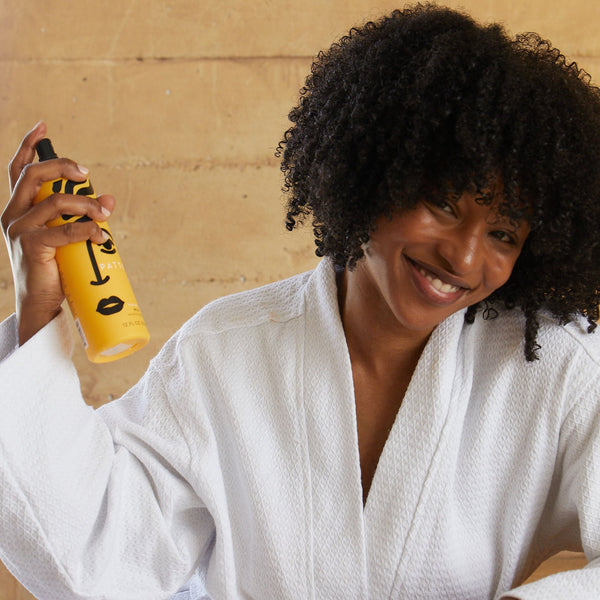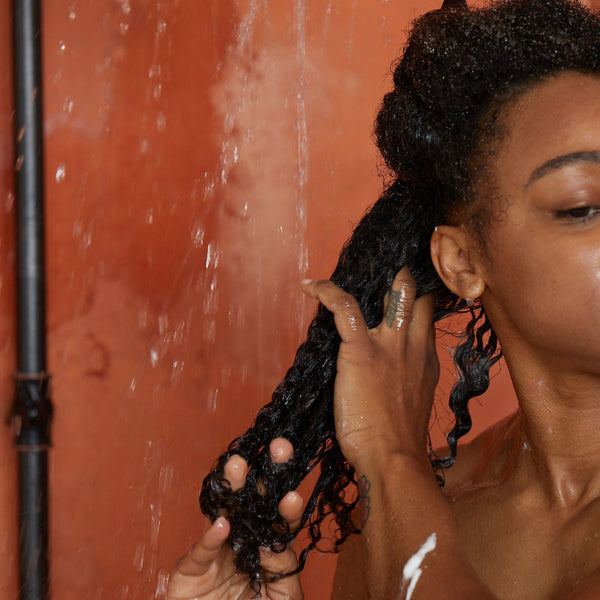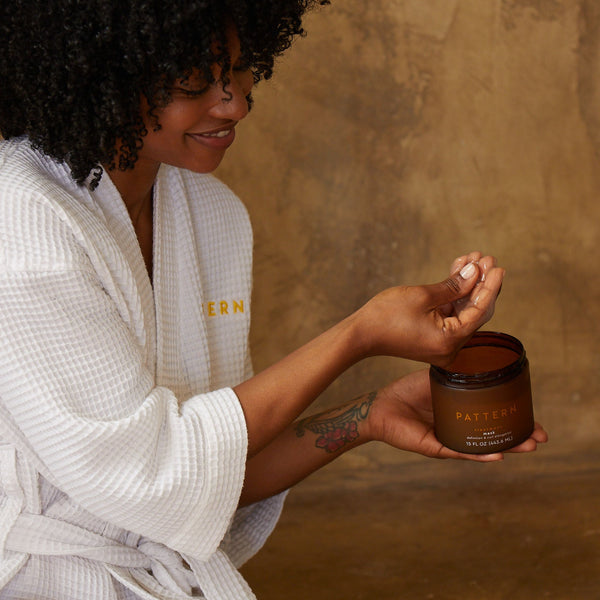You take care to treat your natural curls with the respect they deserve—you wait ample time between wash days, you moisturize with nourishing hair masks & you definitely wear a satin scarf to bed every night.
So, when you notice split ends, you may start to wonder where you went wrong with your curly hair care routine. But the truth is that split ends can sneak their way into even the healthiest head of coils.
Luckily, there are plenty of ways to repair your hair & prevent split ends no matter your texture type. But for our curly hair kings & queens, hold onto your curls as we discuss everything you need to know about split ends so that you can say goodbye to yours for good.
What Are Split Ends?
Split ends occur when the ends of your hair follicles are in a dry or brittle state. When you brush your hair, those brittle strands can fray & unravel at the end.1
& voila—split ends.
To the naked eye, a single split end will look like a piece of hair that’s been separated into two pieces, similar to a road that veers off in two directions. But what do split ends look like on curly hair?
Curly damaged hair split ends actually look very similar to split ends on other hair types . Here’s what to look for on the ends of your strands to determine if you have split ends:
- Y-shaped pieces at the tip of a strand
- Some pieces of hair that are thinner at the ends than others
- A single hair shaft that splits directly up the middle
Interestingly, curly & coily hair types are more prone to split ends than other hair types. This is because of the propensity for dryness (due to curl patterns). In other words, although your scalp may be producing an ample amount of sebum (a naturally moisturizing oil), that sebum may not be reaching the ends of your hair. This can leave your tips without moisture, making them more susceptible to breakage & split ends.2
What Causes Split Ends in Natural Hair?
There are numerous reasons you may find yourself with split ends. Natural hair is vulnerable to multiple stressors that can cause split ends, including:3
- Brushing your hair while it’s dry – Brushing hair when it’s dry can damage your cuticle & cause frizz. Not only that, but it can also disrupt your natural curl pattern & stretch your hair cuticle, which may cause natural hair breakage or split ends. Instead of dry brushing, try using one of PATTERN’s brushes or combs to detangle your hair while it’s still damp to minimize your chances of creating new split ends.
- Using heated styling tools – Although excessive exposure to heat is known to cause hair damage, you don’t need to throw your heated styling tools away. Instead, you can use a product like PATTERN’s Heat Protectant before you bust out your hot tools (whether that be your hair dryer or curling iron) to protect your hair from high temperatures. The heat protectant acts like a barrier between your hair & the heat, sealing in moisture & sending frizz packing.
- Using protective styles that are too tight – We know, it sounds counterintuitive—but it does happen. Sometimes, your seemingly perfectly executed box braids or top knot is tighter than necessary, which can over-stretch your hair follicles & cause split ends & breakage. If you’re conscientious as you’re creating your protective hairstyle, you can ensure a flawless look, protect your hair & step out as the hair care-conscious queen (or king) you are.
- Drying your hair by rubbing it with a towel – It might seem efficient at times, but rubbing your wet hair with a towel could lead to excess friction on your hair’s cuticles. Too much friction could lift the cuticles, leading to frizz, potential breakage & split ends. Instead of rubbing your hair with a towel to dry it, try wrapping your hair in PATTERN’s Microfiber Towel after your shower. The tiny fibers are more efficient at absorbing the water in your hair & won’t rough up your cuticles in the process.
- Overbrushing your hair – We can brush our hair too much—& it can have negative consequences on our curls. That said, try to be considerate of how often you brush. We recommend combing or brushing your hair sparingly, like on days you detangle your hair or directly after washing it. Be sure to also use the right types of brushes for curly hair.
How to Protect Your Curls From Split Ends
Noticing split ends? Don’t fret, curlies & coilies. With the right tips & tricks, you can repair any current breakage & learn ways to protect your hair from future cases of split ends.
Natural hair is meant to be fun & fabulous—& with these helpful hints, yours will be back in the healthy hair game in no time:
- Use a sulfate-free shampoo – Some shampoos contain sulfates to help remove excess oil & dirt from your hair.2 However, those sulfates may be removing too much oil & causing your hair follicles to dry out. This could result in breakage or frizz. Instead, opt for shampoo & conditioner for curly hair that is free of sulfates. Make sure you only wash your hair as needed—every few days to a week or longer, depending on the type of curls you have.
- Focus on conditioning – When it comes to protecting your hair from split ends, conditioning your hair should be one of your top priorities. Your hair is naturally dryer than other hair types, so consider stocking up on conditioning essentials like our Leave-In Conditioner & Transition Mask to help your hair retain its peak moisture levels. In the case where you are searching for a way to build the strength of your strands, reach for our Treatment Mask. When using conditioning products, be sure to coat your strands from root to tip to fully penetrate the entire hair follicle.
- Detangle your hair regularly – If you only detangle your hair on wash days, you’re leaving yourself with a lot of work to do. Instead, you can keep your hair free of fairy knots & save yourself some time on wash days by detangling on a normal basis. To detangle, you can wet your hair & apply a leave-in conditioner. Then, use a tool like our Wide Tooth Comb to free your hair of any knots, working from the ends of your hair & going upward as you remove each knot. Alternatively, you could also apply a detangler on damp hair & use a comb to get rid of any unruly tangles.
- See your stylist for a trim – A tried-&-true way to relieve your hair of split ends is by receiving regular trims from your hairstylist. If you’re having your hair trimmed on a normal basis, they’ll only need to cut off the bare minimum & you’ll barely notice. (What you will notice is how much healthier your ends look & feel!)
-
Take care of your hair at night – When it comes to sleeping with curly hair, learning how to properly preserve your curls at night is like perfecting an art form. Everyone has their own unique pattern & curly hair night routine, so what works to preserve one person’s curls won’t necessarily work on someone else’s. You can try pulling your hair into a loose ponytail on top of your head (like a pineapple). If that doesn’t maintain your curls the way you’d like, you can sleep in a loose braid. You can also wear your hair in a silk or satin bonnet, such as PATTERN’s Satin Cap.
The beauty of all these options is that they keep your hair from rubbing against your pillowcase. The friction caused by your hair rubbing against your pillowcase can lead to split ends & the potential to lose your natural curl pattern until the next wash day
How to Identify Split Ends vs Dead Ends
If you’ve never heard of dead ends, worry not. They’re similar to split ends in that they represent damage to the ends of your strands. The difference, however, lies in what causes them:4
- Split ends are usually caused by overstressing the ends of your hair. This usually happens from brushing dry hair or overbrushing.
- Dead ends usually occur from heat styling, chemical processing or having extremely under-moisturized hair.
So, how can you identify a dead end vs a split end?
A split end looks like one piece of hair that splits up the middle, whereas a dead end is usually a broken piece of hair. This means the strand may be brittle, frizzy or dull in appearance. While it may seem easy to tell the difference, the only surefire way to know for sure is by asking your stylist to take a gander at your ends.
If you do have dead ends, your stylist can remove them by trimming your hair. You can also choose to treat them with a hydrating repair mask or deep conditioner.
Protect Your Curls & Coils with PATTERN
Keeping your curlies & coilies in pristine condition takes effort, but it’s completely possible—& in the long run, your hair will thank you. Plus, with the right hair care tools & products, you’ll have everything you need to ensure juicy, joyful & split end-free curls.
With PATTERN tools & products in particular, you can upgrade your current curl care routine & take your hair health to the next level. From curly hair treatments to curly hair styling products made specifically for your unique pattern, we can help you embrace your natural texture while providing your hair with the protection it deserves.
Sources:
- NIH. Semi-permanent split end mending with a polyelectrolyte complex. https://pubmed.ncbi.nlm.nih.gov/17728946/
- NIH. Hair Cosmetics: An Overview. https://www.ncbi.nlm.nih.gov/pmc/articles/PMC4387693/
- AAD. 10 Hair Care Habits That Can Damage Your Hair. https://www.aad.org/public/everyday-care/hair-scalp-care/hair/habits-that-damage-hair
- Hair Style Camp. Dead Ends vs. Split Ends: Can You Tell the Difference? https://hairstylecamp.com/dead-ends-vs-split-ends/
